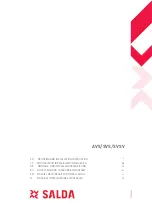
MSDS
– CS1000
Effective 5-1-2012
Page 3 of 6
6.
ACCIDENTAL RELEASE MEASURES
PERSONAL PRECAUTIONS:
Use proper personal protection (refer to Section 8).
ENVIRONMENTAL PRECAUTIONS:
Run off from fire control or dilution water may cause pollution.
Keep out of drains, municipal sewers, open bodies of water and water course.
CLEAN-UP METHODS:
Safely stop source of spill. Clean up spills immediately. Restrict non-essential
personnel from the area. Wear protective clothing, goggles and respirator if ventilation is not adequate.
Dike spill area and soak up material with sand or other absorbent. Place into chemical waste container
for disposal according to local, state or federal regulations. Flush spill area with water.
7.
HANDLING AND STORAGE
HANDLING:
Use proper personal protection when handling (refer to Section 8). Use under well-
ventilated conditions. Avoid contact with eyes, skin and clothing. Avoid breathing vapors and mists.
Avoid prolonged or repeated contact. Do NOT ingest. Wash thoroughly after handling. Rinse container
before disposal.
SHELF LIFE:
The recommended shelf life is two (2) years. It is recommended that products be retested
if stored for more than two (2) years. Under ideal storage conditions, the shelf life is almost indefinite.
STORAGE TEMPERATURE:
The recommended storage temperature is above 32
o
F, preferably at room
temperature (70
o
F).
GENERAL:
Store closed containers in a cool, dry, well-ventilated area away from incompatible materials.
This product is stable under normal conditions of handling and storage. Avoid cold temperatures.
8.
EXPOSURE CONTROLS / PERSONAL PROTECTIVE EQUIPMENT
Please refer to Section 2 for applicable exposure limits.
EYE PROTECTION:
To avoid contact with eyes, use chemical splash goggles and a face shield. Eye
wash station should be available in the work area.
HAND PROTECTION:
Use rubber or plastic gloves to minimize skin contact.
BODY PROTECTION:
Use a rubber apron to minimize contact. Rubber boots are recommended. Full
drench shower should be available in the work area.
RESPIRATOR:
Use of respirator protection is not generally required. However, if exposure is above the
stated limits or ventilation is inadequate, use a NIOSH approved acid gas/organic vapor respirator to
reduce potential for inhalation exposure. When using respirator cartridges, they must be changed
frequently to assure breakthrough exposure does not occur.
VENTILATION:
General mechanical ventilation is recommended for enclosed areas.
9.
PHYSICAL AND CHEMICAL PROPERTIES
Appearance:
Clear, pink liquid
Boiling Point:
100
o
C / 212
o
F
Odor:
Musty
Freezing Point:
0
o
C / 32
o
F
Specific Gravity
@ 68
o
F
:
~ 1.17
Vapor Pressure:
23.75 mmHg
pH:
> 12.5
Vapor Density
(air = 1)
:
ND
Water Solubility:
Complete
VOC Content:
Non-volatile
Содержание AM4A0A18S11SA Series
Страница 1: ......
Страница 2: ......
Страница 3: ......
Страница 4: ......
Страница 100: ...96 CLCH SVX07C EN Installation Electrical Figure 84 Typical VFD wiring schematic ...
Страница 101: ...CLCH SVX07C EN 97 Installation Electrical Figure 85 Typical starter wiring schematic ...
Страница 135: ...CLCH SVX07C EN 131 Notes ...
Страница 146: ...10 1 2 STEP 8 Lift the Coil section up and away from the Blower section Set aside ...
Страница 178: ......
Страница 188: ...2 ...
Страница 189: ...3 ...
Страница 190: ...4 ...
Страница 198: ...w w w p r i c e h v a c c o m 6 SDV5000 c w direct digital controls SERVICE INSTALLATION MANUAL Notes ...
Страница 199: ...SDV5000 c w direct digital controls SERVICE INSTALLATION MANUAL w w w p r i c e h v a c c o m 7 ...
Страница 201: ......
Страница 202: ......
Страница 203: ......
Страница 204: ......
Страница 205: ......
Страница 206: ......
Страница 207: ......
Страница 208: ......
Страница 209: ......
Страница 210: ......
Страница 211: ......
Страница 212: ......
Страница 213: ......
Страница 214: ......
Страница 215: ......
Страница 216: ......
Страница 250: ......
Страница 251: ......

































